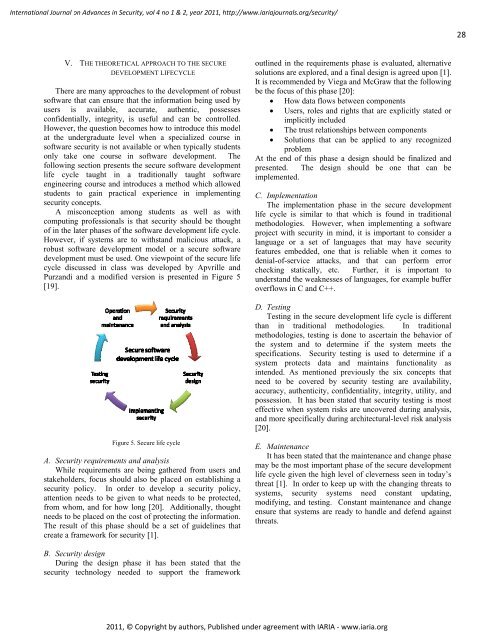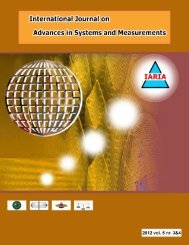Fault Tolerance Framework using Model-Based - IARIA Journals
Fault Tolerance Framework using Model-Based - IARIA Journals
Fault Tolerance Framework using Model-Based - IARIA Journals
You also want an ePaper? Increase the reach of your titles
YUMPU automatically turns print PDFs into web optimized ePapers that Google loves.
International Journal on Advances in Security, vol 4 no 1 & 2, year 2011, http://www.iariajournals.org/security/<br />
V. THE THEORETICAL APPROACH TO THE SECURE<br />
DEVELOPMENT LIFECYCLE<br />
There are many approaches to the development of robust<br />
software that can ensure that the information being used by<br />
users is available, accurate, authentic, possesses<br />
confidentially, integrity, is useful and can be controlled.<br />
However, the question becomes how to introduce this model<br />
at the undergraduate level when a specialized course in<br />
software security is not available or when typically students<br />
only take one course in software development. The<br />
following section presents the secure software development<br />
life cycle taught in a traditionally taught software<br />
engineering course and introduces a method which allowed<br />
students to gain practical experience in implementing<br />
security concepts.<br />
A misconception among students as well as with<br />
computing professionals is that security should be thought<br />
of in the later phases of the software development life cycle.<br />
However, if systems are to withstand malicious attack, a<br />
robust software development model or a secure software<br />
development must be used. One viewpoint of the secure life<br />
cycle discussed in class was developed by Apvrille and<br />
Purzandi and a modified version is presented in Figure 5<br />
[19].<br />
Figure 5. Secure life cycle<br />
A. Security requirements and analysis<br />
While requirements are being gathered from users and<br />
stakeholders, focus should also be placed on establishing a<br />
security policy. In order to develop a security policy,<br />
attention needs to be given to what needs to be protected,<br />
from whom, and for how long [20]. Additionally, thought<br />
needs to be placed on the cost of protecting the information.<br />
The result of this phase should be a set of guidelines that<br />
create a framework for security [1].<br />
B. Security design<br />
During the design phase it has been stated that the<br />
security technology needed to support the framework<br />
outlined in the requirements phase is evaluated, alternative<br />
solutions are explored, and a final design is agreed upon [1].<br />
It is recommended by Viega and McGraw that the following<br />
be the focus of this phase [20]:<br />
• How data flows between components<br />
• Users, roles and rights that are explicitly stated or<br />
implicitly included<br />
• The trust relationships between components<br />
• Solutions that can be applied to any recognized<br />
problem<br />
At the end of this phase a design should be finalized and<br />
presented. The design should be one that can be<br />
implemented.<br />
C. Implementation<br />
The implementation phase in the secure development<br />
life cycle is similar to that which is found in traditional<br />
methodologies. However, when implementing a software<br />
project with security in mind, it is important to consider a<br />
language or a set of languages that may have security<br />
features embedded, one that is reliable when it comes to<br />
denial-of-service attacks, and that can perform error<br />
checking statically, etc. Further, it is important to<br />
understand the weaknesses of languages, for example buffer<br />
overflows in C and C++.<br />
D. Testing<br />
Testing in the secure development life cycle is different<br />
than in traditional methodologies. In traditional<br />
methodologies, testing is done to ascertain the behavior of<br />
the system and to determine if the system meets the<br />
specifications. Security testing is used to determine if a<br />
system protects data and maintains functionality as<br />
intended. As mentioned previously the six concepts that<br />
need to be covered by security testing are availability,<br />
accuracy, authenticity, confidentiality, integrity, utility, and<br />
possession. It has been stated that security testing is most<br />
effective when system risks are uncovered during analysis,<br />
and more specifically during architectural-level risk analysis<br />
[20].<br />
E. Maintenance<br />
It has been stated that the maintenance and change phase<br />
may be the most important phase of the secure development<br />
life cycle given the high level of cleverness seen in today’s<br />
threat [1]. In order to keep up with the changing threats to<br />
systems, security systems need constant updating,<br />
modifying, and testing. Constant maintenance and change<br />
ensure that systems are ready to handle and defend against<br />
threats.<br />
2011, © Copyright by authors, Published under agreement with <strong>IARIA</strong> - www.iaria.org<br />
28







